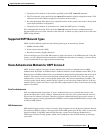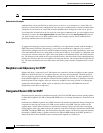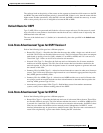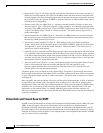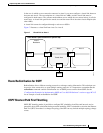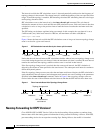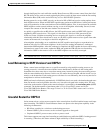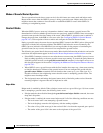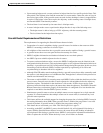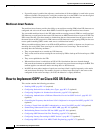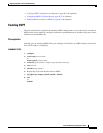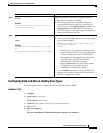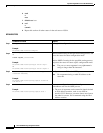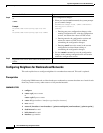
Implementing OSPF on Cisco IOS XR Software
Information About Implementing OSPF on Cisco IOS XR Software
RC-143
Cisco IOS XR Routing Configuration Guide
• Upon entering helper mode, a router performs its helper function for a specific period of time. This
time period is the lifetime value from the router that is in restart mode—minus the value of lsage in
the received grace LSA. If the graceful restart succeeds in time, the helper’s timer is stopped before
it expires. If the helper’s timer does expire, the adjacency to the restarting router is brought down,
and normal OSPFv3 functionality resumes.
• The dead timer is not honored by the router that is in helper mode.
• A router in helper mode ceases to perform the helper function in any of the following cases:
–
The helper router is able to bring up a FULL adjacency with the restarting router.
–
The local timer for the helper function expires.
Graceful Restart Requirements and Restrictions
The requirements for supporting the Graceful Restart feature include:
• Cooperation of a router’s neighbors during a graceful restart. In relation to the router on which
OSPFv3 is restarting, each router is called a helper.
• All neighbors of the router that does a graceful restart must be capable of doing a graceful restart.
• A graceful restart does not occur upon the first-time startup of a router.
• OSPFv3 neighbor information and database information are not check-pointed.
• An OSPFv3 process rebuilds adjacencies after it restarts.
• To ensure consistent databases after a restart, the OSPFv3 configuration must be identical to the
configuration before the restart. (This requirement applies to self-originated information in the local
database.) A graceful restart can fail if configurations change during the operation. In this case, data
forwarding would be affected. OSPFv3 resumes operation by regenerating all its LSAs and
resynchronizing its database with all its neighbors.
• Although IPv6 FIB tables remain unchanged during a graceful restart, these tables eventually mark
the routes as stale through the use of a holddown timer. Enough time is allowed for the protocols to
rebuild state information and converge.
• The router on which OSPFv3 is restarting must send OSPFv3 hellos within the dead interval of the
process restart. Protocols must be able to retain adjacencies with neighbors before the adjacency
dead timer expires. The default for the dead timer is 40 seconds. If hellos do not arrive on the
adjacency before the dead timer expires, the router takes down the adjacency. The OSPFv3 Graceful
Restart feature does not function properly if the dead timer is configured to be less than the time
required to send hellos after the OSPFv3 process restarts.
• Simultaneous graceful restart sessions on multiple routers are not supported on a single network
segment. If a router determines that multiple routers are in restart mode, it terminates any local
graceful restart operation.
• This feature utilizes the available support for changing the purge time of existing OSPFv3 routes in
the routing information base (RIB). When graceful restart is enabled, the purge timer is set to 90
seconds by default. If graceful restart is disabled, the purge timer setting is 0.
• This feature has an associated grace LSA. This link-scope LSA is type 11.
• According to the RFC, the OSPFv3 process should flush all old, self-originated LSAs during a
restart. With the Graceful Restart feature, however, the router delays this flushing of unknown
self-originated LSAs during a graceful restart. OSPFv3 can learn new information and build new
LSAs to replace the old LSAs. When the delay is over, all old LSAs are flushed.



